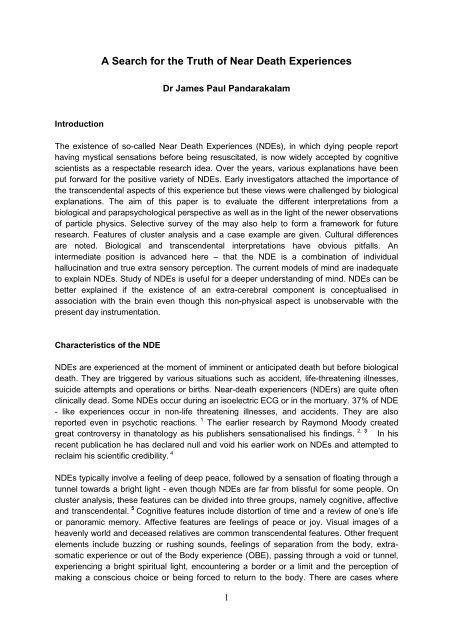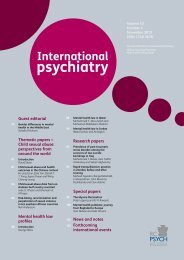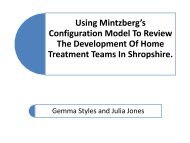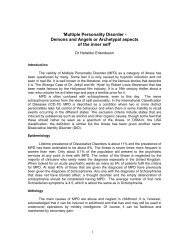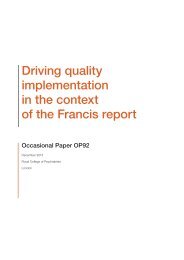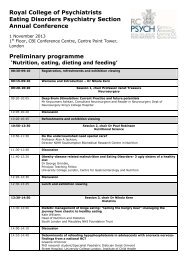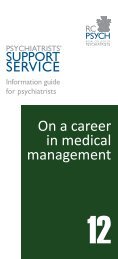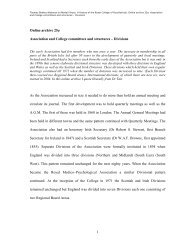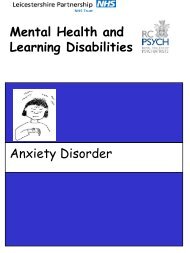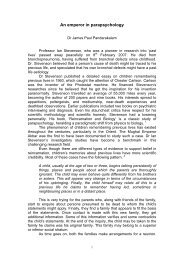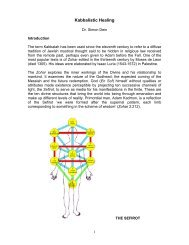A Search for the Truth of Near Death Experiences
A Search for the Truth of Near Death Experiences
A Search for the Truth of Near Death Experiences
You also want an ePaper? Increase the reach of your titles
YUMPU automatically turns print PDFs into web optimized ePapers that Google loves.
A <strong>Search</strong> <strong>for</strong> <strong>the</strong> <strong>Truth</strong> <strong>of</strong> <strong>Near</strong> <strong>Death</strong> <strong>Experiences</strong><br />
Dr James Paul Pandarakalam<br />
Introduction<br />
The existence <strong>of</strong> so-called <strong>Near</strong> <strong>Death</strong> <strong>Experiences</strong> (NDEs), in which dying people report<br />
having mystical sensations be<strong>for</strong>e being resuscitated, is now widely accepted by cognitive<br />
scientists as a respectable research idea. Over <strong>the</strong> years, various explanations have been<br />
put <strong>for</strong>ward <strong>for</strong> <strong>the</strong> positive variety <strong>of</strong> NDEs. Early investigators attached <strong>the</strong> importance <strong>of</strong><br />
<strong>the</strong> transcendental aspects <strong>of</strong> this experience but <strong>the</strong>se views were challenged by biological<br />
explanations. The aim <strong>of</strong> this paper is to evaluate <strong>the</strong> different interpretations from a<br />
biological and parapsychological perspective as well as in <strong>the</strong> light <strong>of</strong> <strong>the</strong> newer observations<br />
<strong>of</strong> particle physics. Selective survey <strong>of</strong> <strong>the</strong> may also help to <strong>for</strong>m a framework <strong>for</strong> future<br />
research. Features <strong>of</strong> cluster analysis and a case example are given. Cultural differences<br />
are noted. Biological and transcendental interpretations have obvious pitfalls. An<br />
intermediate position is advanced here – that <strong>the</strong> NDE is a combination <strong>of</strong> individual<br />
hallucination and true extra sensory perception. The current models <strong>of</strong> mind are inadequate<br />
to explain NDEs. Study <strong>of</strong> NDEs is useful <strong>for</strong> a deeper understanding <strong>of</strong> mind. NDEs can be<br />
better explained if <strong>the</strong> existence <strong>of</strong> an extra-cerebral component is conceptualised in<br />
association with <strong>the</strong> brain even though this non-physical aspect is unobservable with <strong>the</strong><br />
present day instrumentation.<br />
Characteristics <strong>of</strong> <strong>the</strong> NDE<br />
NDEs are experienced at <strong>the</strong> moment <strong>of</strong> imminent or anticipated death but be<strong>for</strong>e biological<br />
death. They are triggered by various situations such as accident, life-threatening illnesses,<br />
suicide attempts and operations or births. <strong>Near</strong>-death experiencers (NDErs) are quite <strong>of</strong>ten<br />
clinically dead. Some NDEs occur during an isoelectric ECG or in <strong>the</strong> mortuary. 37% <strong>of</strong> NDE<br />
- like experiences occur in non-life threatening illnesses, and accidents. They are also<br />
reported even in psychotic reactions. 1 The earlier research by Raymond Moody created<br />
great controversy in thanatology as his publishers sensationalised his findings. 2, 3 In his<br />
recent publication he has declared null and void his earlier work on NDEs and attempted to<br />
reclaim his scientific credibility. 4<br />
NDEs typically involve a feeling <strong>of</strong> deep peace, followed by a sensation <strong>of</strong> floating through a<br />
tunnel towards a bright light - even though NDEs are far from blissful <strong>for</strong> some people. On<br />
cluster analysis, <strong>the</strong>se features can be divided into three groups, namely cognitive, affective<br />
and transcendental. 5 Cognitive features include distortion <strong>of</strong> time and a review <strong>of</strong> one’s life<br />
or panoramic memory. Affective features are feelings <strong>of</strong> peace or joy. Visual images <strong>of</strong> a<br />
heavenly world and deceased relatives are common transcendental features. O<strong>the</strong>r frequent<br />
elements include buzzing or rushing sounds, feelings <strong>of</strong> separation from <strong>the</strong> body, extrasomatic<br />
experience or out <strong>of</strong> <strong>the</strong> Body experience (OBE), passing through a void or tunnel,<br />
experiencing a bright spiritual light, encountering a border or a limit and <strong>the</strong> perception <strong>of</strong><br />
making a conscious choice or being <strong>for</strong>ced to return to <strong>the</strong> body. There are cases where<br />
1
OBE involve externally verifiable in<strong>for</strong>mation. 6 After <strong>the</strong> NDE, <strong>the</strong> subjects generally keep<br />
quiet about <strong>the</strong>ir experience; <strong>the</strong>y talk about it only in appropriate situations. 30% <strong>of</strong> NDErs<br />
<strong>for</strong>get <strong>the</strong> experience because <strong>of</strong> <strong>the</strong> dream-like and dissociative nature <strong>of</strong> <strong>the</strong> experience,<br />
and <strong>the</strong> involvement <strong>of</strong> <strong>the</strong> amnesia-prone temporal lobe. Some remember it only under<br />
hypnosis.<br />
NDErs can experience a reverse cultural shock, undergoing a revolution <strong>of</strong> values and<br />
opinions. They develop decreased fear <strong>of</strong> death and increased conviction <strong>of</strong> after-death<br />
existence. Non-religious people may become religious or spiritually oriented. They develop<br />
more sense <strong>of</strong> responsibility and give more importance to acquiring knowledge. There are<br />
psycho-hygienic effects and NDErs have less suicidal inclinations. All true NDErs cherish<br />
nostalgia <strong>for</strong> <strong>the</strong> experience and find a com<strong>for</strong>t in it in tough times.<br />
Michael Sabom, using a Life Changes Questionnaire and <strong>the</strong> previously developed Religious<br />
Motivation Scale, found significant differences between <strong>the</strong> patients who had had an NDE<br />
and who had not. 7 The life changes noted included enhanced faith in a supreme power,<br />
sanctity <strong>of</strong> life and a desire <strong>for</strong> positive human engagement. However, up to a quarter <strong>of</strong><br />
NDEs are negative. Experiencers <strong>of</strong> negative NDE also report an OBE and a dark transition<br />
zone, but accompanied by unpleasant feelings <strong>of</strong> fear or panic. They describe encountering<br />
bad <strong>for</strong>ces or beings, and entering a hellish environment. But negative NDEs also have a<br />
positive life changing effect. Unsurprisingly, negative NDEs are more suppressed than<br />
positive NDEs.<br />
A Case <strong>of</strong> NDE or NDE-like experience<br />
The following account <strong>of</strong> an NDE from my own case file has some <strong>of</strong> <strong>the</strong> ingredients <strong>of</strong> an<br />
NDE, even though <strong>the</strong>re is no evidence to suggest that <strong>the</strong> subject had a somatic death but<br />
was in a physiological crisis. It is not a classic case <strong>of</strong> NDE and I am quoting this case to<br />
illustrate that some <strong>of</strong> <strong>the</strong> reported cases <strong>of</strong> NDE are very similar to normal experiences in<br />
physiological crisis.<br />
‘I am now an old aged pensioner (aged 77), but over past years have had occasions<br />
<strong>of</strong> being rushed into hospital, more than once on a 50/50 chance <strong>of</strong> survival. I would<br />
like to relate <strong>of</strong> one such occasion in particular, where I could say, ‘Yes I did have a<br />
brush with death, but my experience was so vivid and real, I was totally convinced I<br />
had died and returned’. Starting from when <strong>the</strong> anaes<strong>the</strong>tist put <strong>the</strong> needle in <strong>the</strong><br />
back <strong>of</strong> my hand. ‘Just a little prick’, he said, and counted up to ten. I remember 7 or<br />
8. My head seemed to leave me empty – a loud buzzing, <strong>the</strong>n a rushing noise and<br />
sound as I went into a dark tunnel. It was like being in an express train, but not<br />
literally, as I didn’t seem to be enclosed and I could see far ahead and notice <strong>the</strong><br />
open light at <strong>the</strong> end <strong>of</strong> <strong>the</strong> tunnel approaching nearer and nearer all <strong>the</strong> time,<br />
although it seemed endless in matter <strong>of</strong> time. On leaving <strong>the</strong> ‘tunnel’, my first<br />
impression was that I was in Heaven. But oh dear, it was nothing that I was ever led<br />
to believe from all <strong>the</strong> beliefs and stories. It was so totally unexpected and out <strong>of</strong><br />
character. The ‘beyond’ was so flat and massive, no end in sight! No hills or mounds,<br />
no buildings <strong>of</strong> any nature. No trees or gardens <strong>of</strong> so called roses, yet it was so<br />
tranquil beautiful. No signs or even a hint <strong>of</strong> what we have on earth planet. You first<br />
2
step out into space. There is not even ground or earth to walk on; you first float along<br />
as a bird would fly. Visions <strong>of</strong> people were <strong>the</strong>re like a vast community, but <strong>the</strong>re was<br />
nothing to touch <strong>the</strong>y had no material body but masses <strong>of</strong> colour about <strong>the</strong>ir spiritual<br />
entity. Each one wore a single long garment in <strong>the</strong> palest <strong>of</strong> blues, greens, yellows<br />
and purple - <strong>the</strong>re appeared no black or white or even red but all o<strong>the</strong>r shades <strong>of</strong><br />
colour. One couldn’t describe <strong>the</strong> garments as <strong>the</strong>y are not manufactured. Just<br />
apparitions swa<strong>the</strong>d in mist like – appearances. They just floated around, like walking<br />
on a cloud. There was a delightful scent and odour in <strong>the</strong> air about <strong>the</strong>m but place<br />
was very calm and peaceful, I felt totally relaxed and happy. I was at rest within<br />
myself. Time seemed non-existent. I wanted to stay <strong>the</strong>re, disappointed only because<br />
I cannot recollect seeing or meeting any <strong>of</strong> my family, friends or acquaintances, as on<br />
earth. I sincerely did believe <strong>the</strong>y lived on <strong>the</strong> o<strong>the</strong>r side along with our individual and<br />
spiritual guides. However I was drawn back to <strong>the</strong> tunnel, stepped in, and entered. All<br />
<strong>the</strong> emptiness within me seemed to disappear. I had enjoyed <strong>the</strong> feeling <strong>of</strong> love and<br />
peace and now I was experiencing a sense <strong>of</strong> life coming back into my body, but<br />
could do nothing myself. There were no thoughts, just unexplainable senses that I<br />
was aware <strong>of</strong>. I just floated along again, but had <strong>the</strong> strange knowledge that I was not<br />
on a level, as I seemed to be flying higher and higher upwards - it didn’t seem at all<br />
like <strong>the</strong> tunnel I had previously gone down. As I came out <strong>of</strong> <strong>the</strong> end <strong>of</strong> <strong>the</strong> tunnel, I<br />
had <strong>the</strong> awareness <strong>of</strong> something or someone gently smacking my face, <strong>the</strong>n heard<br />
my name being called out, and on opening my eyes, <strong>the</strong> light was overpowering and I<br />
wanted to close <strong>the</strong>m again, but once more I was smacked a little more roughly and<br />
harder and heard <strong>the</strong> words ‘Come on Mr L -, can you hear me?’ Suddenly I realised<br />
that I had entered my own physical body! I was back in my hospital bed, alive and<br />
back in my ward, and realised or thought it had all been a dream. I have never<br />
<strong>for</strong>gotten that experience and yes, I would say I ‘passed over’ or had my brush with<br />
death but was allowed to return to life and my realities again. But I shall never be<br />
afraid <strong>of</strong> death again; <strong>the</strong>re is nothing to be frightened <strong>of</strong> anymore’.<br />
Interpretations <strong>of</strong> NDEs<br />
Even after a quarter <strong>of</strong> a century <strong>of</strong> research into NDE phenomena, <strong>the</strong>re is no consensus <strong>of</strong><br />
opinion among <strong>the</strong> scientific community with regard to its interpretation. There are organic,<br />
pharmacological, physiological, neurological psychological, socio-cultural, paranormal and<br />
spiritual explanations. Ernest Rodin (1980) considered NDE as a final psychosis where <strong>the</strong><br />
dying individual acts as his own judge, jury, accuser, prosecutor, defence attorney and<br />
witness. 8 He or she alone renders <strong>the</strong> final verdict <strong>of</strong> guilty or not guilty. According to <strong>the</strong><br />
pharmacological view, NDEs are <strong>the</strong> products <strong>of</strong> <strong>the</strong> drugs administered during <strong>the</strong> illness.<br />
9,10,11 However, <strong>the</strong>re are NDE cases in cultures where no advanced modern treatment is<br />
available. In India, where patients are looked after at home, <strong>the</strong>re are full-blown cases <strong>of</strong><br />
NDE. It is argued that psychotropic drugs only interfere with <strong>the</strong> perception <strong>of</strong> NDE and block<br />
<strong>the</strong> memories. The physiological view is that NDE is due to <strong>the</strong> cessation <strong>of</strong> oxygen to <strong>the</strong><br />
brain during <strong>the</strong> clinical death and represents <strong>the</strong> last compensatory gasp <strong>of</strong> <strong>the</strong> dying brain.<br />
12,13<br />
CO 2 accumulation is said to explain <strong>the</strong> tunnel experience but that does not explain <strong>the</strong><br />
life review and <strong>the</strong> Light Beings. NDEs have also taken place when <strong>the</strong> measured oxygen<br />
level was well above <strong>the</strong> average level. While <strong>the</strong> possible physiological mechanism<br />
3
underlying NDEs have been speculated upon, <strong>the</strong>re is no research demonstrating <strong>the</strong> actual<br />
physiological conditions associated with NDEs. 14,15,16<br />
According to <strong>the</strong> biochemical view hallucinatory neurotransmitters and endorphins are<br />
thought to be responsible <strong>for</strong> NDEs. 17,18 So far, no NDE specific transmitter constellations<br />
have been detected. Stress-induced limbic lobe dysfunction is a neurological explanation. 14<br />
Ano<strong>the</strong>r neurological view is that <strong>the</strong> ‘NDE is similar to <strong>the</strong> autoscopic hallucination. 19 In <strong>the</strong><br />
OBE, <strong>the</strong> centre <strong>of</strong> thinking is in <strong>the</strong> ‘second body’ and in <strong>the</strong> case <strong>of</strong> autoscopic<br />
hallucination <strong>the</strong> centre <strong>of</strong> thinking is still in <strong>the</strong> physical body. Electrical stimulation <strong>of</strong> <strong>the</strong><br />
temporal lobe has produced NDE-like experiences. However, visual hallucinations in this<br />
situation as well as in temporal lobe epilepsy are mere visual disturbances and not intact<br />
visual images as in NDE perceptions. The NDE has also been hypo<strong>the</strong>sised to be a<br />
protective mechanism to conserve energy and provide necessary brain stimuli. 20<br />
Hart (1954) identified 288 published cases in which a person claimed to have perceived<br />
events at some distant location while in <strong>the</strong> extra-somatic state. 21 It is also worth mentioning<br />
that OBE have been reported to occur in healthy individuals and under experimental<br />
conditions. 22,23,24,25 Depersonalisation syndrome occurring at <strong>the</strong> time <strong>of</strong> life threatening<br />
danger was ano<strong>the</strong>r speculation. 26 Psychologists have postulated that NDEs are <strong>the</strong> product<br />
<strong>of</strong> mental defence mechanisms – denial, dissociation, wish fulfilment, regression and<br />
projection. Yet in <strong>the</strong> NDE, <strong>the</strong> subject is not escaping from <strong>the</strong> situation; he is frequently<br />
witnessing <strong>the</strong> scene <strong>of</strong> resuscitation. NDEs have common elements and are independent <strong>of</strong><br />
<strong>the</strong> belief system. Even when patients are sure to recover, <strong>the</strong>y may still experience an NDE.<br />
The replay <strong>of</strong> birth experience has been a popular psychological explanation. 27 Regression<br />
is used to explain <strong>the</strong> mystical elements (regression to a state be<strong>for</strong>e ego differentiation). But<br />
again, <strong>the</strong> NDE is experienced with an integrated ego identity.<br />
The tunnel experience is compared to <strong>the</strong> birth canal experience. New-born children have<br />
very poor perception <strong>of</strong> objects. But NDEers have full perception <strong>of</strong> objects. Nei<strong>the</strong>r is <strong>the</strong><br />
birth experience a ‘positive’ one. People who had Caesarean births also have had NDEs.<br />
Tunnel experiences are reported to occur with hallucinogenic drugs, hypnogogic and ecstatic<br />
states, argued to be <strong>the</strong> result <strong>of</strong> over activity <strong>of</strong> <strong>the</strong> visual cortex and not announcing<br />
proximity <strong>of</strong> death. The collective unconscious and <strong>the</strong> archetypes are used to explain NDE.<br />
However, OBEs cannot be explained according to Jungian <strong>the</strong>ories. Finally, NDEs have<br />
been compared to o<strong>the</strong>r mental reactions to perceived threat, coloured by culture and<br />
current stress. 28<br />
None <strong>of</strong> <strong>the</strong> organic and psychological <strong>the</strong>ories explain <strong>the</strong> externally verifiable in<strong>for</strong>mation<br />
<strong>the</strong> subjects give after <strong>the</strong> bodily separation. How can some persons who are ostensibly<br />
unconscious, if not dead, never<strong>the</strong>less perceive <strong>the</strong>ir bodies from above, and sometimes<br />
become aware <strong>of</strong> events occurring outside <strong>the</strong> reach <strong>of</strong> <strong>the</strong>ir ordinary senses? The biological<br />
interpretations do not adequately explain <strong>the</strong> enhanced cognitive abilities <strong>of</strong> <strong>the</strong> NDErs. 29<br />
Parapsychologists believe that enhanced cognitive abilities when <strong>the</strong> brain is underactive<br />
point towards a true involvement <strong>of</strong> extra sensory perception (telepathy, clairvoyance,<br />
precognition). Philosophically oriented investigators think that NDE points towards an<br />
intrinsic spiritual reality. They attach even transcendental importance to <strong>the</strong> reports <strong>of</strong> Light<br />
Beings, making it a symbol <strong>of</strong> modern mysticism outside <strong>the</strong> religious field. 30 Peter Fenwick’s<br />
recent studies have revealed several features <strong>of</strong> NDE that do not con<strong>for</strong>m to <strong>the</strong> usual<br />
4
eductionist view. 31 He states that NDE can occur when a person is unconscious, which<br />
suggests that NDEs may not be purely subjective because in <strong>the</strong> state <strong>of</strong> unconsciousness,<br />
<strong>the</strong> modules <strong>of</strong> <strong>the</strong> brain responsible <strong>for</strong> <strong>the</strong> construction <strong>of</strong> <strong>the</strong> world are <strong>of</strong>f-line. There are<br />
cognitive scientists who hold <strong>the</strong> view that NDEs are symptoms <strong>of</strong> dissociative states or<br />
post-traumatic stress disorder. But Bruce Greyson’s studies suggest that <strong>the</strong> NDEr’s stress<br />
response is a normal reaction to an anomalous expression ra<strong>the</strong>r than a psychopathological<br />
response. 32<br />
Four Swiss physicians claimed to have induced OBE by focal electrical stimulation <strong>of</strong> <strong>the</strong><br />
brain <strong>of</strong> a patient undergoing surgical evaluation <strong>for</strong> epilepsy treatment, and drew <strong>the</strong><br />
premature conclusion that <strong>the</strong> part <strong>of</strong> <strong>the</strong> brain that can induce OBE has been located. 33<br />
During <strong>the</strong> procedure, <strong>the</strong> patient reported that she was sinking into <strong>the</strong> bed or falling from a<br />
height. The authors report that ‘When asked to look at her outstretched arms during<br />
electrical stimulation...<strong>the</strong> patient felt as though her left arm was shortened; <strong>the</strong> right arm<br />
was unaffected. If both arms were in <strong>the</strong> same position but bent by 90 degrees at <strong>the</strong> elbow,<br />
she felt lower arm and hand were moving towards her face... When her eyes were shut, she<br />
felt that her upper body was moving toward her legs, which were stable.’ 33 In fact, <strong>the</strong><br />
experience reported might have been an atypical OBE or OBE-like experience. Electrical<br />
stimulation is a mechanism and not a cause and in <strong>the</strong> case <strong>of</strong> both intentional and<br />
spontaneous OBEs, <strong>the</strong> cause, that is, <strong>the</strong> external or internal trigger, is still a mystery. 34<br />
NDEs and Children<br />
Very young children, as soon as <strong>the</strong>y are able to speak, have reported NDEs <strong>the</strong>y had as<br />
infants, or even in <strong>the</strong> process <strong>of</strong> being born. NDEs <strong>of</strong> children are different from <strong>the</strong> family<br />
teachings <strong>of</strong> death, and <strong>the</strong>ir experiences are structured similar to <strong>the</strong> adult ones. In <strong>the</strong><br />
OBEs, <strong>the</strong>y see <strong>the</strong>mselves as adults and not as baby spirits. But some have also seen <strong>the</strong>ir<br />
living playmates in <strong>the</strong>ir NDE. Atwater, who herself had three NDEs in 1977, posits that<br />
‘children who had near-death episodes are remodelled, rewired, reconfigured and are <strong>the</strong><br />
refined version <strong>of</strong> <strong>the</strong> original.’ 35 Children who have experienced NDEs display precocious<br />
wisdom and certainty about life after death. Frightening childhood NDEs are rare in <strong>the</strong><br />
literature, but a few have been reported. Such experiences lead to nightmares, restlessness,<br />
and prolonged anxiety among <strong>the</strong> children. These distressing experiences begin or end with<br />
a positive note. <strong>Near</strong> death research is an area where subject matter cannot be observed<br />
directly and so it is difficult to do quality research. Children’s narration <strong>of</strong> NDEs is particularly<br />
valuable and enlightening because <strong>the</strong>y report accurately what <strong>the</strong>y experience without<br />
undue apprehension over <strong>the</strong> rational interpretation <strong>of</strong> <strong>the</strong>ir experiences.<br />
NDEs <strong>of</strong> <strong>the</strong> Blind<br />
Kenneth Ring’s study <strong>of</strong> NDEs among blind persons sought corroborative evidence<br />
regarding <strong>the</strong> au<strong>the</strong>nticity <strong>of</strong> <strong>the</strong>ir unusual experience. He claimed that even those blind from<br />
birth reported classic NDEs and <strong>the</strong> great majority <strong>of</strong> those claimed to see during <strong>the</strong>ir<br />
NDEs-eyeless vision. 36 A few <strong>of</strong> <strong>the</strong>m reported visually based knowledge, whose<br />
truthfulness was independently verified, which could not have been acquired by ordinary<br />
means. In King’s and Cooper’s study <strong>of</strong> blind people’s NDEs, 80% claimed some visual<br />
5
perceptions during <strong>the</strong> NDE or OBE encounters. 36 It was also noticed that sometimes <strong>the</strong><br />
initial onset <strong>of</strong> visual perceptions <strong>of</strong> <strong>the</strong> physical world was disorienting and even distressing<br />
to <strong>the</strong> blind. <strong>Near</strong>-death researchers who are enthusiastic about cases <strong>of</strong> veridical<br />
paranormal perception generally overlook hallucinatory NDEs, and <strong>the</strong>re is clear evidence<br />
that NDErs have sometimes false perceptions <strong>of</strong> physical world. 37 The over-enthusiasm <strong>of</strong><br />
such passionate survival researchers may have been a defence against <strong>the</strong> reductionist<br />
stance <strong>of</strong> <strong>the</strong> last century.<br />
<strong>Death</strong> Bed Visions<br />
There is ano<strong>the</strong>r body <strong>of</strong> evidences in thanatology supporting <strong>the</strong> paranormal components <strong>of</strong><br />
<strong>the</strong> clinical death experience. They are described as pre-death visions and are particularly<br />
interesting as <strong>the</strong>y occur in full consciousness. 38 These experiences include visions <strong>of</strong> dead<br />
friends and relatives, visions <strong>of</strong> landscapes from beyond, and heightened sensations <strong>of</strong><br />
elation or euphoria in <strong>the</strong> immediate period preceding real death. Some <strong>of</strong> <strong>the</strong> ingredients <strong>of</strong><br />
clinical death experiences are identical to <strong>the</strong> deathbed visions occurring at <strong>the</strong> edge <strong>of</strong> life,<br />
which cannot be easily explained away in biological terms. While healthy persons report<br />
hallucinations <strong>of</strong> living individuals, truly dying people claim hallucinations <strong>of</strong> deceased<br />
persons. The visions <strong>of</strong> dying persons may be considered as a defensive attempt to reduce<br />
death anxiety by imagining reunion with familiar persons. However, this view is challenged<br />
by cases in which a person near death has reported seeing a recently deceased person <strong>of</strong><br />
whose death <strong>the</strong> experiencer had no normal in<strong>for</strong>mation. 39,40,41,42,43,44<br />
Thomas Alva Edison’s last words in his death bed were, ‘It is very beautiful over <strong>the</strong>re’. He<br />
supposedly had o<strong>the</strong>r worldly pre-death vision. Fr. Damien <strong>of</strong> Molokai, who dedicated his life<br />
to <strong>the</strong> outcast leprosy patients from Hawaii, is believed to have had pre-death visions <strong>of</strong><br />
Jesus and Mary when bystanders noticed that he was staring at a particular spot around his<br />
death bed. <strong>Death</strong> bed visions occur more frequently but less reported even though <strong>the</strong>y<br />
provide stronger evidence <strong>for</strong> post mortem existence. 45 They may be true departing visions,<br />
where as NDEs can be designated only as parting visions.<br />
Shared <strong>Death</strong> <strong>Experiences</strong><br />
Shared death experiences (SDE) are a new addition to survival research even though<br />
Myers’ mentioned such experiences in his classic book on survival problem. These<br />
experiences include persons present at <strong>the</strong> death <strong>of</strong> <strong>the</strong>ir loved ones experiencing leaving<br />
<strong>the</strong>ir own bodies, viewing <strong>the</strong> life review <strong>of</strong> <strong>the</strong>ir loved ones and travelling part-way towards<br />
<strong>the</strong> Light. Such experiences though common, have been rarely reported in NDE literature.<br />
Raymond Moody names <strong>the</strong>se experiences as ‘empathic NDEs’, ‘conjoint NDEs’ or ‘mutual<br />
NDEs’. 46 Like death bed visions, shared real death experiences could immensely contribute<br />
to <strong>the</strong> evidences <strong>for</strong> discarnate survival. Peter and Elizabeth Fenwick reported a case where<br />
<strong>the</strong> daughter who sat beside her mo<strong>the</strong>r’s deathbed experienced a ‘vision’ and during this<br />
vision she saw a beautiful garden and hillside from which she saw a dead aunt holding out<br />
her hands to her dying mo<strong>the</strong>r, and <strong>the</strong> mo<strong>the</strong>r and aunt meeting and going away toge<strong>the</strong>r. 31<br />
6
Raymond Moody recognises seven elements in cases <strong>of</strong> SDE: change <strong>of</strong> geometry, mystical<br />
light, music and musical sounds, OBEs, co-living a life review, encountering unworldly<br />
realms and mist at death. 47 All <strong>the</strong> elements are not normally present in <strong>the</strong> reported cases<br />
and a few <strong>of</strong> <strong>the</strong> seven elements may be present in individual cases. Moody has recounted<br />
his own SDE <strong>of</strong> his mo<strong>the</strong>r in 1994 along with <strong>the</strong> rest <strong>of</strong> <strong>the</strong> Moody family. 47 ‘ When my own<br />
mo<strong>the</strong>r died in 2005, my two sisters, who were at her bedside, shared a similar vision during<br />
which <strong>the</strong>y saw my deceased bro<strong>the</strong>r – who was a pr<strong>of</strong>essor <strong>of</strong> <strong>for</strong>ensic medicine –<br />
appearing with a smile and taking <strong>the</strong> hands <strong>of</strong> our dying mo<strong>the</strong>r, both <strong>the</strong>n moving upwards<br />
and disappearing from sight’. Shared real death experiences cannot be explained away with<br />
<strong>the</strong> biological interpretations <strong>of</strong> NDEs. Moody proposes that <strong>the</strong> ‘mirror neurons’ <strong>of</strong> <strong>the</strong><br />
empathic system might contain <strong>the</strong> clue to explain <strong>the</strong> mechanism <strong>of</strong> transmission <strong>of</strong> SDE. 47<br />
Dogmatic science may argue that SDEs are merely folie a deux or anecdotal experiences<br />
that cannot be replicated<br />
Induced ADCs<br />
After death communications (ADCs) with pr<strong>of</strong>oundly loving experiences may assist grieving<br />
process. Spontaneous ADCs in <strong>the</strong> <strong>for</strong>m <strong>of</strong> auditory, visual, tactile and olfactory <strong>for</strong>ms have<br />
been reported. ADC is thought to produce psychological reconnection and resolution where<br />
traditional grief counselling only helps achieve a level <strong>of</strong> acceptance <strong>of</strong> <strong>the</strong> loss. During my<br />
clinical practice I have come across a number <strong>of</strong> my patients seeking <strong>the</strong> help <strong>of</strong> <strong>the</strong><br />
psychically gifted to resolve <strong>the</strong>ir grief reaction and <strong>the</strong>se pr<strong>of</strong>essionals attempt to<br />
communicate with <strong>the</strong> deceased or apparently facilitate <strong>the</strong> departed to communicating with<br />
<strong>the</strong> loved ones.<br />
The Psychomanteum is a mirror room set up to optimise psychological effects such as<br />
trance state. Low light, flickering light and a mirror are key feature. Sensory deprivation is<br />
helpful <strong>for</strong> trance induction. The participants first reminisce about <strong>the</strong> deceased loved ones<br />
and gaze at a mirror in such a darkened room. They feel contact from <strong>the</strong> deceased in <strong>the</strong><br />
<strong>for</strong>m <strong>of</strong> messages, visions, touches and a feeling <strong>of</strong> presence. These experiences do not<br />
contribute to evidences <strong>of</strong> life after death. Raymond Moody uses such rooms as a<br />
<strong>the</strong>rapeutic tool to heal grief. 48 One may remember <strong>the</strong> psychedelic explorers <strong>of</strong> <strong>the</strong> sixties<br />
who also experienced ‘bad trips’. Mirror encounters could tear apart some <strong>of</strong> <strong>the</strong><br />
unsuspecting explorers. 49<br />
Allen Botkin has experimented with induced ADCs through eye movement desensitisation<br />
and reprocessing (EMDR) technique. He posits that multisensory ADCs are similar to NDEs.<br />
50 ADCs occur to people who are alive and healthy and who experience ano<strong>the</strong>r who has<br />
died, whereas NDEs happen to people who are apparently approaching death. The induced<br />
ADC experiencers report that <strong>the</strong>y sometimes go through a passageway be<strong>for</strong>e <strong>the</strong>y get to<br />
<strong>the</strong> deceased and are loving encounters. They also report beautiful landscapes, but never<br />
claim to have come across <strong>the</strong> Light Being encountered in NDEs. 50 It is argued that <strong>the</strong><br />
quality and psychological impact <strong>of</strong> both induced ADCs and NDEs are identical though<br />
experienced with different perspectives. Botkin’s comparison <strong>of</strong> NDEs and EMDR-induced<br />
ADCs, as well as his assertion that such a treatment modality will resolve <strong>the</strong> sense <strong>of</strong> loss<br />
associated with grief reaction, has been challenged. 51 However, some <strong>the</strong>ologians who<br />
recommend <strong>the</strong> healing powers <strong>of</strong> prayer and sacramental nourishment consider ADC<br />
7
through <strong>the</strong> Psychomanteum and EMDR-induced ADC as perverted <strong>for</strong>ms <strong>of</strong> healing grief<br />
and may even label <strong>the</strong>m as ‘black arts’.<br />
Medjugorje Parallels<br />
Craig Lundahl has made a courageous comparison between Medjugorje visionary<br />
experiences (1981 - ) with NDErs who describe post-mortem existence consisting <strong>of</strong> two<br />
major divisions, with <strong>the</strong> possibility <strong>of</strong> a third division. 52 One <strong>of</strong> <strong>the</strong> major division is <strong>the</strong><br />
‘Cities <strong>of</strong> Light’ with <strong>the</strong>ir countryside. The second major division is <strong>the</strong> ‘Realm <strong>of</strong> Bewildered<br />
Spirits’. A third division called ‘hell’ is suggested by a few NDErs. The distinction between<br />
such a realm and <strong>the</strong> second division is not clear according to most NDErs. The Cities <strong>of</strong><br />
Light are built <strong>of</strong> crystal cool light and appear at different levels, with each city more grand<br />
than <strong>the</strong> last one and are characterised by intense level <strong>of</strong> activity. They are surrounded by<br />
countryside with beautiful landscapes <strong>of</strong> mountains, hills, valleys, fields <strong>of</strong> golden grass and<br />
flowers, meadows, paths, trails, lanes, roads, great <strong>for</strong>ests, brooks, streams, rivers, ponds<br />
and lakes. 53 The Realm <strong>of</strong> Bewildered Spirits is described as a dark, gloomy, and hostile<br />
environment where <strong>the</strong>re are millions <strong>of</strong> unhappy and wicked people who are grey,<br />
bewildered, confused, miserable, anguished, dreary, angry and uncommunicative and<br />
preoccupied with unresolved problems. 53<br />
Mo<strong>the</strong>r Mary has <strong>of</strong>fered in<strong>for</strong>mation about different <strong>for</strong>ms <strong>of</strong> discarnate survival through <strong>the</strong><br />
percipients <strong>of</strong> Medjugorje apparitional occurrences and has given <strong>the</strong>m glimpses <strong>of</strong> postmortem<br />
conditions <strong>of</strong> time-fullness where past, present and future are blended<br />
harmoniously (Heaven), timelessness where <strong>the</strong>re are not any changes (purgatory) and<br />
eternal damnation where no changes are possible. 54 Unlike physical personalities who live<br />
in <strong>the</strong> space-time dimension, discarnate personalities trapped in <strong>the</strong> timeless dimension<br />
(purgatory) cannot bring about changes in <strong>the</strong>ir personality swiftly and could be trapped in<br />
that stage <strong>for</strong> centuries. There are different levels in this dimension and <strong>the</strong>y tally with<br />
Monroe’s description <strong>of</strong> <strong>the</strong> four locales found in his extra-somatic voyages. 55,56<br />
The Marian apparition has also reaffirmed <strong>the</strong> existence <strong>of</strong> negative and positive entities. All<br />
<strong>the</strong> visionaries were shown Heaven, Purgatory and Hell in visions except Mirjana Drgicevic<br />
and Ivanka Ivankovic, who did not want to see Hell. Two <strong>of</strong> <strong>the</strong> seers, Vicka and Jackov<br />
claim that <strong>the</strong>y have been teleported to o<strong>the</strong>r realms by <strong>the</strong> apparition and little Jackov<br />
resisted initially having to leave his mo<strong>the</strong>r! 54 Brown H.M. records that <strong>the</strong>se two<br />
visionaries were bodily transported to <strong>the</strong>se realms, during which <strong>the</strong>y reportedly<br />
disappeared <strong>for</strong> twenty minutes. 57 When I interviewed Ivan Dragicevic, <strong>the</strong> Medjugorje<br />
visionary insisted that it was not out <strong>of</strong> <strong>the</strong> body travel resulting in paradise-scenes. He also<br />
questioned whe<strong>the</strong>r such things as OBE really exist, as he had never heard about NDEs.<br />
According to Vicka and Jackov <strong>the</strong>y had experienced a true transportation. None <strong>of</strong> <strong>the</strong>m<br />
claim to have encountered <strong>the</strong> Light Being or historical Biblical figures. The third division<br />
with <strong>the</strong> features <strong>of</strong> Hell, a realm described by Marian visionaries, has not been established<br />
or delineated in NDE studies. The visionaries assert that this realm has a particular<br />
environment and strange people.<br />
The Fatima visionaries (Portugal, 1917) were shown a vision <strong>of</strong> Hell and <strong>the</strong> Marian<br />
apparition at Fatima also made mention <strong>of</strong> <strong>the</strong> realm <strong>of</strong> bewildered spirits and heaven. NDE<br />
8
narrations propose that <strong>the</strong> level <strong>of</strong> <strong>the</strong> dimension <strong>the</strong> NDEr travels is dependent upon <strong>the</strong><br />
amount <strong>of</strong> energy levels and frequencies <strong>of</strong> light in <strong>the</strong> spiritual body <strong>of</strong> <strong>the</strong> individual and<br />
are based on human behaviours while on earth, possibly depending also on <strong>the</strong> energy<br />
level and frequencies <strong>of</strong> light <strong>of</strong> <strong>the</strong> helpers coming to assist <strong>the</strong>ir transition. 58 In Fatima and<br />
Medjugorje, <strong>the</strong>re is indication <strong>of</strong> a new era in human history, marked by human<br />
bro<strong>the</strong>rhood, universal love and peace. A small number <strong>of</strong> deep NDErs have reported<br />
consistently prophetic scenarios <strong>for</strong> <strong>the</strong> future <strong>of</strong> Earth: geophysical changes,<br />
meteorological changes, economic collapse and a new era <strong>of</strong> world peace. 43,44,59,60 The<br />
prophetic vision <strong>of</strong> a period <strong>of</strong> peace may tally with Marian apparitional predictions. Nobody<br />
can deny <strong>the</strong> fact that <strong>the</strong>se predicted events are occurring and o<strong>the</strong>rs could follow, even<br />
though majority <strong>of</strong> <strong>the</strong> world community is not cognizant <strong>of</strong> <strong>the</strong>m.<br />
Cultural artefacts<br />
Parting Visions are more talked about in <strong>the</strong> West than in <strong>the</strong> East. The studies <strong>of</strong> NDE<br />
Researchers now indicate that it is a universal phenomenon. 61 Western man is educated to<br />
be reality orientated right from <strong>the</strong> cradle and he has been conditioned to experience himself<br />
and <strong>the</strong> events around him as real. There<strong>for</strong>e, he is prone to regard his last thoughts as real,<br />
whereas oriental people are conditioned to think <strong>of</strong> <strong>the</strong> world as unreal (or Maya) and so<br />
<strong>the</strong>y might regard <strong>the</strong>ir last experiences as also Maya . 62 Culture shapes NDEs, which in turn<br />
contribute to <strong>the</strong> shaping <strong>of</strong> <strong>the</strong> culture. 63 In Indian cases, instead <strong>of</strong> ‘Light Beings’, <strong>the</strong>y are<br />
taken to a Holy Man with a book by functionaries. He discovers a mistake in <strong>the</strong> book and<br />
<strong>the</strong> individual is asked to return to terrestrial life. 64 Post-NDE marks are found in some<br />
Indian cases, 65 branded on <strong>the</strong>ir body in <strong>the</strong> o<strong>the</strong>r realm. These residual marks resulted<br />
from <strong>the</strong> subjects being <strong>for</strong>cefully pushed down (generally those subjects who resisted<br />
coming back from <strong>the</strong> o<strong>the</strong>r realm). From <strong>the</strong> psychological point <strong>of</strong> view, <strong>the</strong>se marks might<br />
have been generated like those <strong>of</strong> stigmatic, due to autosuggestions or intense<br />
concentration on <strong>the</strong> event on <strong>the</strong> part <strong>of</strong> <strong>the</strong> subjects. No review <strong>of</strong> a <strong>for</strong>mer life is described<br />
in NDEs <strong>of</strong> culture believing in reincarnation and this has been used by parapsychologists to<br />
indicate that <strong>the</strong> concept <strong>of</strong> reincarnation is a misinterpretation <strong>of</strong> <strong>the</strong> contact with <strong>the</strong> earthly<br />
life <strong>of</strong> ano<strong>the</strong>r deceased human being. 66 Yet Ian Stevenson has found and reported<br />
evidence that would make this seem possible, although without claiming he has proved<br />
reincarnation. 67<br />
NDEs and Particle Physics<br />
Scientists failed to <strong>of</strong>fer an adequate explanation <strong>for</strong> NDEs mainly because all along <strong>the</strong>y<br />
were using a material cause to describe what may be an o<strong>the</strong>r-worldly phenomenon. 58 The<br />
view held by classical physicists that two objects cannot occupy <strong>the</strong> same space at <strong>the</strong> same<br />
time has been <strong>the</strong> scientific block to believing in <strong>the</strong> very existence <strong>of</strong> a non-physical<br />
component in association with <strong>the</strong> brain, and <strong>the</strong> same confusion is restricting some NDE<br />
researchers in considering non-biological interpretations. This view has been challenged by<br />
post-Einstein physicists. De Broglie’s discovery <strong>of</strong> <strong>the</strong> wave-like nature <strong>of</strong> matter can<br />
accommodate most <strong>of</strong> <strong>the</strong> alleged paranormal phenomenon.<br />
9
Klauber (2000) states that two subatomic particles can exist toge<strong>the</strong>r just as two waves<br />
rolling over <strong>the</strong> ocean heading in opposite directions and passing through each o<strong>the</strong>r<br />
unhindered, occupy <strong>the</strong> same area <strong>of</strong> <strong>the</strong> water surface. 68 Physics <strong>the</strong>orises that all matter,<br />
at <strong>the</strong> basic level, is made up <strong>of</strong> energy which may be diffused as a field, or condensed as a<br />
particle. The discovery <strong>of</strong> neutrinos has made a breakthrough in <strong>the</strong> thinking <strong>of</strong> post-Einstein<br />
science. These are tiny, subatomic particles without any electrical charges and because <strong>the</strong>y<br />
do not couple with electromagnetic <strong>for</strong>ces <strong>the</strong>ir presence goes undetected. Most neutrinos<br />
pass through <strong>the</strong> earth unsca<strong>the</strong>d and at typical reactor energies <strong>the</strong>y can travel 25 light<br />
years in lead be<strong>for</strong>e deflecting. We perceive only when particles in our sense organs are<br />
coupled to <strong>the</strong> particles transmitting particular properties from <strong>the</strong> object and if <strong>the</strong>re is no<br />
coupling, <strong>the</strong>re is no perception. Trillions <strong>of</strong> neutrinos are passing through one’s body every<br />
second and yet no one is able to detect <strong>the</strong>m. They pass through matter virtually without our<br />
being aware <strong>of</strong> <strong>the</strong>ir presence. One can only imagine <strong>the</strong> existence <strong>of</strong> similar unknown<br />
particles not coupled with physical fields, constituting o<strong>the</strong>r worlds co-existing with ours. Only<br />
<strong>the</strong> left handed neutrino (spinning in <strong>the</strong> counter clockwise direction) can interact through <strong>the</strong><br />
weak nuclear <strong>for</strong>ce with ano<strong>the</strong>r particle and be detected, while right handed neutrinos<br />
(spinning clockwise) still escape detection - though <strong>the</strong>y may well exist. Right handed<br />
electrons and quarks have been proven to exist. Thus, <strong>the</strong>re may be a variety <strong>of</strong> neutrinolike<br />
particles, in <strong>the</strong> sense that <strong>the</strong>y are tenuous and imperceptible. It may be conjectured<br />
that <strong>the</strong> extra cerebral component <strong>of</strong> <strong>the</strong> ‘mind stuff’ may be partly or fully composed <strong>of</strong> such<br />
diverse particles. Subtle realms may be made <strong>of</strong> such ‘particle families’ coexisting with our<br />
physical world without our being aware <strong>of</strong> <strong>the</strong>ir existence. Thus, extra dimensions have been<br />
postulated based on elementary-particle physics evidence and <strong>the</strong> possibility <strong>of</strong> our<br />
consciousness extending to o<strong>the</strong>r dimensions has been speculated. 69,70,71,72<br />
String <strong>the</strong>ory in physics can accommodate extra dimensions. The three space dimensions<br />
that we know are embedded in a 10 or 11- dimensional space-time. In o<strong>the</strong>r words, we and<br />
all <strong>the</strong> particles in <strong>the</strong> standard model are trapped in three dimensions and right handed<br />
neutrinos might be free to roam around <strong>the</strong> multidimensional Universe escaping detection . 73<br />
Particle physicists are now in a position to consider <strong>the</strong> tunnel experience more<br />
sympa<strong>the</strong>tically as an extra-cerebral experience, accepting <strong>the</strong> hypo<strong>the</strong>tical existence <strong>of</strong> ‘<strong>the</strong><br />
o<strong>the</strong>r worlds’. 74,75 While arguing that <strong>the</strong> mental state or conviction <strong>of</strong> <strong>the</strong> scientific<br />
investigator influences <strong>the</strong> behaviour <strong>of</strong> <strong>the</strong> external world in some instances, Becker (1990)<br />
states that o<strong>the</strong>r dimensions <strong>of</strong> <strong>the</strong> universe exist that are objectively real but accessible only<br />
to individuals in specific mental state such as <strong>the</strong> NDED. 76 NDEs correspond to <strong>the</strong> quirky<br />
nature <strong>of</strong> wave/particles and <strong>the</strong> expansion <strong>of</strong> consciousness observed in NDEs match up to<br />
<strong>the</strong> principles <strong>of</strong> quantum physics.<br />
The concept <strong>of</strong> ‘mental space’ is helpful in understanding NDE or parting visions. A person’s<br />
physical body is in physical space and his mind exists in a personal mental space - a higher<br />
dimensional space existing like a satellite spatial system occupied by minds, or at least<br />
components <strong>of</strong> minds. 77,78 This concept is now supported by particle physics. Mental events<br />
occur in a space that is different from <strong>the</strong> space we occupy in everyday lives as well from <strong>the</strong><br />
physical space that physicists describe. For example, <strong>the</strong> image <strong>of</strong> a bear that we may hold<br />
in our minds (in <strong>the</strong> absence <strong>of</strong> a live bear) has spatial dimensions, and we can locate that<br />
bear in our minds at a distance from an also imagined river and a salmon in <strong>the</strong> river at<br />
which <strong>the</strong> bear may seem to lunge. We cannot however speak intelligibly about <strong>the</strong> distance<br />
between an imagined bear and its imagined surroundings, yet we can do so about any<br />
10
object that we locate perceptually in physical space. Mental space is a very personal one<br />
and protected from <strong>the</strong> intrusions <strong>of</strong> o<strong>the</strong>r person’s thoughts. Ian Stevenson, who supports<br />
<strong>the</strong> a<strong>for</strong>ementioned hypo<strong>the</strong>sis, states that <strong>the</strong> barriers <strong>of</strong> <strong>the</strong> mental space weaken on rare<br />
occasions, when we experience unusual telepathy and paranormal communications. 79 The<br />
real arena <strong>of</strong> <strong>the</strong> NDE is probably in mental space – <strong>the</strong> complex particle dimension beyond<br />
<strong>the</strong> brain - and it may also be a field <strong>of</strong> subtle energy system. 80,81 Weakening <strong>of</strong> <strong>the</strong> walls <strong>of</strong><br />
<strong>the</strong> mental space may result in getting a glimpse into <strong>the</strong> locales beyond this subatomic<br />
energy system. In <strong>the</strong> NDE <strong>the</strong> individual is exploring his own personal mental space fully<br />
through <strong>the</strong> brain and beyond. 79<br />
The NDE and Lighter Shadow Matter <strong>the</strong>ory<br />
Robert Monroe’s researches – along with <strong>the</strong> plethora <strong>of</strong> reported OBEs and NDEs –<br />
deserves to be af<strong>for</strong>ded attention by <strong>the</strong> die-hard sceptical scientists <strong>of</strong> extra-somatic<br />
experiences who dismiss such phenomena. 55.56 Wassermann (1988) made use <strong>of</strong> <strong>the</strong><br />
concept <strong>of</strong> shadow matter in parapsychology, and has brought psychic phenomena within<br />
<strong>the</strong> mechanistic framework. 82 According to his hypo<strong>the</strong>sis, two interlinked brains exist in<br />
human beings: first an ordinary matter brain as described by medical scientists; and<br />
secondly a shadow matter brain, made up <strong>of</strong> shadow matter. He has attempted to explain –<br />
mechanistically, ra<strong>the</strong>r than neurologically – features <strong>of</strong> out-<strong>of</strong>-body experiences and psi<br />
phenomena in terms <strong>of</strong> shadow matter <strong>the</strong>ory. Inspired by <strong>the</strong> shadow matter <strong>the</strong>ory <strong>of</strong><br />
astrophysics, Wassermann (1993) has proposed that living beings have a twin body that is<br />
made up <strong>of</strong> lighter shadow matter (Shadow Matter Body or SMB) than that <strong>of</strong> <strong>the</strong>ir corporeal<br />
presence. 83 According to Wassermann, OBEs are due to separation <strong>of</strong> <strong>the</strong> SMB from <strong>the</strong><br />
ordinary physical body. 84 The SMB perceives its environment through <strong>the</strong> detection <strong>of</strong><br />
sphotons (shadow matter body photons) from ordinary physical objects while having extrasomatic<br />
experiences. The detection <strong>of</strong> sphotons by <strong>the</strong> SMB is carried out through <strong>the</strong><br />
SMB’s shadow matter eyes that are copies <strong>of</strong> ordinary eyes. Wassermann contends that<br />
similar type <strong>of</strong> perception takes place in <strong>the</strong> NDE. Lighter shadow matter hypo<strong>the</strong>sis is a<br />
fascinating hypo<strong>the</strong>sis, <strong>for</strong> this may be <strong>the</strong> realm where NDEs take place and might explain<br />
<strong>the</strong> lack <strong>of</strong> direct visualisation <strong>of</strong> NDErs in <strong>the</strong> OBE state, <strong>the</strong> NDErs inability to interact with<br />
physical objects and <strong>the</strong> ineffable nature <strong>of</strong> many NDEs. 85 According to Wassermann’s<br />
shadow matter (SM) <strong>the</strong>ory, at <strong>the</strong> start <strong>of</strong> NDE, <strong>the</strong> subject’s SMB splits into two parts. 84 A<br />
thin layer remains bound to <strong>the</strong> top <strong>of</strong> <strong>the</strong> ordinary matter body, while <strong>the</strong> remaining part <strong>of</strong><br />
<strong>the</strong> SM body descends down <strong>the</strong> tunnel that dissociates it from its bonds with <strong>the</strong> ordinary<br />
matter body. The tunnel that is perceived by subjects is <strong>the</strong> interior human body, through<br />
which <strong>the</strong> shadow matter moves during contraction and expansion. The compression <strong>of</strong> this<br />
shadow matter is due to <strong>the</strong> release <strong>of</strong> stored elastic energy. Wassermann elucidates this as<br />
follows: 84 ‘When compression is complete, a reactive event series occurs, with <strong>the</strong><br />
contracted shadow matter re-expanding and moving up <strong>the</strong> tunnel towards <strong>the</strong> thin layer.<br />
During this upward movement <strong>the</strong> thin layer reaches ignition temperatures. It is <strong>the</strong>n<br />
perceived by <strong>the</strong> shadow matter eyes and shadow matter brain <strong>of</strong> <strong>the</strong> SMB as <strong>the</strong> light at <strong>the</strong><br />
end <strong>of</strong> <strong>the</strong> tunnel.’<br />
Wassermann’s postulation that <strong>the</strong> person experiencing <strong>the</strong> NDE floats freely in <strong>the</strong> shadow<br />
matter ocean has several deficiencies. According to Wasserman, <strong>the</strong> incarnate individuals<br />
perceived by <strong>the</strong> NDE subject are hallucinatory figures related by <strong>the</strong> shadow matter brain,<br />
11
not <strong>the</strong>ir discarnate shadow matter bodies. 84 Assuming that this explanation fits <strong>the</strong><br />
phenomenon, <strong>the</strong> resulting conundrum may be resolved by integrating <strong>the</strong> shadow matter<br />
speculations with Smythies’ concept <strong>of</strong> personal mental space. It is significant that <strong>the</strong> SMB<br />
is surrounded by a personal shadow matter or mental space which is composed <strong>of</strong> shadow<br />
matter that is lighter than <strong>the</strong> dark matter. This hypo<strong>the</strong>sised personal space must be well<br />
insulated from <strong>the</strong> exterior world as our mental contents and processes are private and –<br />
except <strong>for</strong> occasional incursions and excursions during paranormal experiences in which we<br />
engage with o<strong>the</strong>r persons – <strong>the</strong>y remain unknown to o<strong>the</strong>rs . 79 It may be conjectured that<br />
SMB is merely floating within this personal shadow matter space once <strong>the</strong> gravitational bond<br />
between <strong>the</strong> ordinary body and SMB is severed and is capable <strong>of</strong> exploring <strong>the</strong> personal<br />
shadow matter/ mental space in detail. If <strong>the</strong> insulation <strong>of</strong> <strong>the</strong> personal shadow matter body<br />
space weakens, those in <strong>the</strong> out <strong>of</strong> <strong>the</strong> body state might get an opportunity to gain some<br />
insight into <strong>the</strong> region beyond.<br />
Reductionists are not able to find a biological origin <strong>for</strong> <strong>the</strong> Light Being. Deviating from a<br />
transcendental explanation, it may be conjectured that <strong>the</strong> Light Being encountered by <strong>the</strong><br />
NDE subject could be one’s own spiritual body. At <strong>the</strong> start <strong>of</strong> <strong>the</strong> NDE, a partial split<br />
between <strong>the</strong> spiritual body and <strong>the</strong> SMB may be brought about. Wasserman’s construction<br />
that it is a split within <strong>the</strong> SMB may be an uneconomical interpretation. In <strong>the</strong> NDE, <strong>the</strong><br />
subject is arguably seeing <strong>the</strong>ir own spiritual body and <strong>the</strong>ir ordinary matter body by way <strong>of</strong><br />
<strong>the</strong> shadow matter brain and shadow matter eyes. In a similar way, I share <strong>the</strong> views <strong>of</strong><br />
Kenneth Ring, who after analysing 102 reports <strong>of</strong> NDEs, posited that in <strong>the</strong> NDE one<br />
communicates with one’s ‘high self ’- an aspect <strong>of</strong> <strong>the</strong> divine ra<strong>the</strong>r than transcendental<br />
reality. 86 NDEs that incorporate an encounter with <strong>the</strong> Light Being may <strong>of</strong>fer evidence <strong>of</strong> <strong>the</strong><br />
existence <strong>of</strong> <strong>the</strong> non-biological component that is <strong>the</strong> spiritual body. The Light Being may be<br />
illustrative <strong>of</strong> <strong>the</strong> beauty and strength <strong>of</strong> <strong>the</strong> spiritual body and <strong>the</strong> dignity <strong>of</strong> human creation.<br />
All <strong>the</strong>se events are probably taking place in <strong>the</strong> personal shadow matter space or in an<br />
adjacent shadow matter space, and not necessarily in transcendental space. The NDE may<br />
be essentially a quantum experience. The concept <strong>of</strong> quantum mind makes <strong>the</strong><br />
interpretations <strong>of</strong> NDE more complex, and <strong>the</strong> quantum mind can fool <strong>the</strong> brain beyond our<br />
imagination. As shadow matter is not scientifically proven to exist, I feel more com<strong>for</strong>table<br />
using <strong>the</strong> term shadow ‘matter like-body’ ra<strong>the</strong>r than ‘lighter shadow matter body’.<br />
A belief in <strong>the</strong> spiritual body tallies with <strong>the</strong> views <strong>of</strong> Jay Alfred who hypo<strong>the</strong>sises that a<br />
human being consists <strong>of</strong> a physical biomolecular body that is closely associated with higherenergy<br />
and lower-energy e<strong>the</strong>real bodies, higher-energy and lower-energy astral bodies and<br />
higher-energy and lower-energy causal bodies. 87 According to this dark plasma <strong>the</strong>ory<br />
(<strong>for</strong>merly known as plasma metaphysics) an ‘e<strong>the</strong>real double’ may support <strong>the</strong> tissues and<br />
biochemical activities in <strong>the</strong> biomolecular body and give it structural integrity. Astral bodies<br />
inhabit <strong>the</strong> astral universe, which has a space-time signature <strong>of</strong> four spatial dimensions and<br />
one time dimension. Causal bodies inhabit <strong>the</strong> causal universe, having a space-time<br />
signature <strong>of</strong> five spatial dimensions and one time dimension. The causal bodies may be<br />
regarded as equivalent to <strong>the</strong> spiritual body <strong>of</strong> <strong>the</strong> faith traditions.<br />
While acknowledging <strong>the</strong> triviality <strong>of</strong> some mediumistic communications, it is still interesting<br />
to note that a non-transcendental explanation <strong>of</strong> <strong>the</strong> Light Being is <strong>of</strong>fered in <strong>the</strong> mediumistic<br />
literature. For instance, Geraldine Cummins (1949) wrote 88 : ‘But <strong>the</strong>re is a special period<br />
when we enter <strong>the</strong> gallery <strong>of</strong> memory and <strong>the</strong> pictures <strong>of</strong> our earth life pass be<strong>for</strong>e us. Then<br />
12
our Spirit (Greater self) is our Judge.’ Blackmore (1993) who considers <strong>the</strong> OBE only to be a<br />
retrospective reconstruction based on sensory cues, may be interpreted as obliquely<br />
stumbling upon this when she says 17 : ‘Perhaps <strong>the</strong> ‘Being <strong>of</strong> Light’ is myself. In fact in any<br />
materialistic view <strong>of</strong> <strong>the</strong> NDE it simply must be, because <strong>the</strong>re is no o<strong>the</strong>r outside <strong>for</strong>ce or<br />
entity that it could be. Maybe at some level I am or could be magnificent, golden, awesome,<br />
loving and unconditionally accepting.’ The NDE may also be an experience beyond our<br />
quantum mind; while <strong>the</strong> quantum mind immensely contributes to <strong>the</strong> whole drama, it may<br />
not necessarily extend beyond our own personal spiritual dimension. The NDE may be a<br />
personal spiritual pilgrimage within ourselves. Blackmore, who has reductionist views, is<br />
sceptical about a personal spiritual dimension. The top-down approach is more fruitful than<br />
bottom up-approach in NDE research.<br />
Discussion<br />
Investigators <strong>of</strong> NDEs nowadays arrive at two conclusions. According to one school <strong>of</strong><br />
thought <strong>the</strong> NDE is a combination <strong>of</strong> individual hallucinations and psychological defence<br />
mechanisms: by means <strong>of</strong> <strong>the</strong> NDE, <strong>the</strong> brain is just assisting <strong>the</strong> dying person to die, <strong>the</strong><br />
NDE being <strong>the</strong> ultimate tranquilliser <strong>of</strong> <strong>the</strong> brain. A moderate view is that <strong>the</strong> NDE is a<br />
combination <strong>of</strong> individual hallucination and true extra sensory perception, indicative <strong>of</strong> nonphysical<br />
realities in association with <strong>the</strong> brain. According to C.D. Broad’s compound <strong>the</strong>ory,<br />
mind consists <strong>of</strong> an organic factor and a psychogenic factor, <strong>the</strong> psi component, which is<br />
capable <strong>of</strong> independent existence and may survive physical extinction. 89 The psi component<br />
coexists with <strong>the</strong> brain, like a coloured aqueous solution and sponge existing toge<strong>the</strong>r at <strong>the</strong><br />
same locality even though <strong>the</strong>y have different properties; particle physics might only explain<br />
<strong>the</strong> watery component, with <strong>the</strong> spiritual factor <strong>of</strong> <strong>the</strong> mind represented by <strong>the</strong> colouring<br />
pigment quantum represents <strong>the</strong> solvent carrying <strong>the</strong> colouring pigment.<br />
Ehrenwald made a courageous start in linking psychiatry and parapsychology. 90 He<br />
observed that psi phenomena are more likely to occur during deficit states <strong>of</strong> <strong>the</strong> organism,<br />
and also postulated that psi develops as a compensatory phenomenon. Psi faculties are<br />
mobilised to prevent <strong>the</strong> impending separation and that results in <strong>the</strong> colourful NDE. Such a<br />
phenomenon <strong>of</strong> mobilising psi faculties is thought to occur be<strong>for</strong>e a major psychotic<br />
experience, which would explain <strong>the</strong> NDE in association with psychotic reactions. 1 In my<br />
clinical practice, I have come across patients suffering from bipolar disorder recounting NDElike<br />
experiences in <strong>the</strong> early stages <strong>of</strong> manic phase. In <strong>the</strong> NDE ‘<strong>the</strong> brain–psi component<br />
intimacy’ is in peril and <strong>the</strong> central <strong>the</strong>me <strong>of</strong> <strong>the</strong> NDE is all about rescuing <strong>the</strong> brain and <strong>the</strong><br />
psi component from a premature partition, with parting visions as <strong>the</strong> ultimate defence, since<br />
mechanisms <strong>of</strong> <strong>the</strong> brain and <strong>the</strong> psi component seek to coexist. The jigsaw puzzle <strong>of</strong> <strong>the</strong><br />
NDE can be solved by introducing <strong>the</strong> compound <strong>the</strong>ory <strong>of</strong> <strong>the</strong> mind into <strong>the</strong> discussion.<br />
Through <strong>the</strong> NDE <strong>the</strong> brain is apparently preparing <strong>the</strong> dying individual <strong>for</strong> a life beyond <strong>the</strong><br />
body. Yet negative NDEs pose a problem in this regard. Whatever maybe <strong>the</strong> chosen<br />
interpretation, NDEs have physical substrate containing psycho-bio-neurological<br />
components. Enhanced cognitive abilities, <strong>the</strong> experience <strong>of</strong> seeing <strong>the</strong> physical body from a<br />
different position in space and paranormal perceptions are features that need fur<strong>the</strong>r studies.<br />
A comparative appraisal <strong>of</strong> pre-death visions and shared death experiences might give a<br />
clearer paranormal insight.<br />
13
Subjective experiences like NDE may elude scientific explanation. Mystical experiences are<br />
internal to <strong>the</strong> experience itself and are self-validating. Those who have had an NDE claim<br />
<strong>the</strong>y ‘know’ that <strong>the</strong>re is life after death and do not just ‘believe’ in discarnate survival. The<br />
person in my reported case did not have a clinical death but a major physiological crisis,<br />
suggesting his NDE was not a true After <strong>Death</strong> Experience (ADE). Still, he seems to have<br />
got rid <strong>of</strong> his fear <strong>of</strong> death. A good portion <strong>of</strong> NDEs fall into this group, warranting a better<br />
classification <strong>of</strong> NDEs, now used as an umbrella term <strong>for</strong> all <strong>the</strong> unusual experiences<br />
associated with death. There are NDE-like experiences and variable intensity in true NDEs.<br />
In general, NDEs cannot be considered as ADEs. NDEs <strong>of</strong> extreme duration or deep NDEs<br />
may contain a few unswerving elements <strong>of</strong> ADE. Even veridical OBEs do not at all indicate<br />
ADE but may only prove that consciousness can exist independent <strong>of</strong> brain. The NDErs’<br />
perception <strong>of</strong> <strong>the</strong> o<strong>the</strong>r dimensions is comparable to <strong>the</strong> limited and faulty world perception<br />
<strong>of</strong> a new born child, needing to be weighed against revealed in<strong>for</strong>mation from <strong>the</strong><br />
representatives <strong>of</strong> <strong>the</strong> transcendental reality (like Mo<strong>the</strong>r Mary). NDEs present evidence <strong>for</strong><br />
<strong>the</strong> existence <strong>of</strong> a non-physical component in union with <strong>the</strong> brain and might <strong>of</strong>fer an indirect<br />
evidence <strong>for</strong> discarnate existence, but not its pro<strong>of</strong>. Likewise, NDE may be indirect evidence<br />
<strong>for</strong> survival after physical extinction. <strong>Death</strong> bed observations and shared death experiences<br />
<strong>of</strong>fer <strong>the</strong> least complex evidence <strong>for</strong> after death existence.<br />
There are warnings against too readily making metaphysical and particularly<br />
parapsychological speculations on <strong>the</strong> basis <strong>of</strong> particle physics 92 and <strong>the</strong> present author<br />
respects <strong>the</strong>m. Particle physics might unravel certain aspects <strong>of</strong> Mind but <strong>the</strong> mind will<br />
continue to be shrouded in mystery. After all, quantum mechanics is only a rock-bottom<br />
<strong>the</strong>ory <strong>of</strong> matter. 93 Neutrino physics makes <strong>the</strong> invisible more tangible. Relating shadow<br />
matter to <strong>the</strong> NDE is an intriguing hypo<strong>the</strong>sis but we are still long way from proving <strong>the</strong><br />
validity, or lack <strong>the</strong>re<strong>of</strong>, <strong>of</strong> this hypo<strong>the</strong>sis.<br />
The <strong>the</strong>ological stance is that all spontaneous psychic experiences including NDEs, visions,<br />
out -<strong>of</strong>- body experiences, and precognition should be carefully evaluated, while <strong>the</strong> soughtafter<br />
variety should be flatly avoided. 94 The observations <strong>of</strong> <strong>the</strong> Marian visionaries <strong>of</strong><br />
Medjugorje may <strong>of</strong>fer some corroboration <strong>for</strong> <strong>the</strong> City <strong>of</strong> Light and <strong>the</strong> Realm <strong>of</strong> Bewildered<br />
Spirits elements <strong>of</strong> <strong>the</strong> NDE from a source o<strong>the</strong>r than NDEs. 52 Lundahl, who has been<br />
criticized <strong>for</strong> incorporating Mormon views into <strong>the</strong> NDE literature, has demonstrated his open<br />
mindedness by comparing and contrasting <strong>the</strong> NDE with <strong>the</strong> Marian apparitions. The words<br />
<strong>of</strong> <strong>the</strong> late Fr Slavko Barbaric, <strong>the</strong> <strong>the</strong>n spiritual director <strong>of</strong> <strong>the</strong> visionaries and who was<br />
familiar with paranormal literature are highly significant when he said: ‘I think <strong>the</strong>y were<br />
permitted to see… so that <strong>the</strong>y could witness to us... so <strong>the</strong>y are naive witnesses- ‘we know<br />
it exists, we saw it’’’. 95 Quoting <strong>the</strong> words <strong>of</strong> <strong>the</strong> Medjugorje scholar, Lundahl wonders<br />
whe<strong>the</strong>r that is also <strong>the</strong> message <strong>the</strong> NDErs who have seen <strong>the</strong> o<strong>the</strong>r world have been<br />
trying to give. 52 Studies <strong>of</strong> death related experiences are a human search through science<br />
to find <strong>the</strong>ir destiny in time, and Marian apparitions are a Mo<strong>the</strong>rly attempt to guide her<br />
children to find <strong>the</strong>ir destiny in Eternity.<br />
Post-mortem existence has relevance in debatable issues like euthanasia and capital<br />
punishment because it highlights <strong>the</strong> sanctity <strong>of</strong> earthly life. The studies <strong>of</strong> NDEs have<br />
usefulness in cognitive science. The different elements <strong>of</strong> <strong>the</strong> NDE point towards <strong>the</strong><br />
multipartite nature <strong>of</strong> consciousness and <strong>the</strong>reby contribute vastly to consciousness studies.<br />
Study <strong>of</strong> NDEs may be useful in understanding certain aspects <strong>of</strong> <strong>the</strong> psychotic process.<br />
14
They help us to study <strong>the</strong> dying process and impart a deeper understanding <strong>of</strong> <strong>the</strong> mind.<br />
They are useful in counselling grieving families and helping suicidal patients. Neal<br />
Grossman, a pr<strong>of</strong>essor <strong>of</strong> philosophy involved in NDE research writes: 96 ‘I have been<br />
immersed in this research <strong>for</strong> 30 years or so, and have been incorporating this material in<br />
my courses. I have seen <strong>the</strong> effect that just reading this material has had on <strong>the</strong> lives <strong>of</strong> my<br />
students. I have seen suicidal impulses dissipate, relationship with family healed, and<br />
directionless students acquiring a sense <strong>of</strong> direction. I have seen students who were<br />
motivated primarily by <strong>the</strong> desires <strong>of</strong> <strong>the</strong> materialistic creed (greed, fame, pleasure and<br />
power) begin to think seriously about living according to <strong>the</strong> Golden Rule ...’<br />
References:<br />
1. Kemp Lindsey & Treloar J. Adrian (1997) <strong>Near</strong>-death experience in association with<br />
psychotic illness, Journal <strong>of</strong> psychiatric case reports, volume 2 No1 p 107-108.<br />
2. Moody Raymond (1975) Life after death. New York: Bantam.<br />
3. Moody Raymond (1988) Light Beyond. New York.<br />
4. Moody Raymond (1999) The Last Laugh. Charlottesville, VA: Hampton Roads Publishing<br />
Company.<br />
5. Greyson Bruce (1985) A typology <strong>of</strong> near-death experiences. American Journal <strong>of</strong><br />
Psychiatry, 142, 967-9.<br />
6. Greyson Bruce (1983) The psychodynamics <strong>of</strong> near death experiences. Journal <strong>of</strong><br />
Nervous and Mental Diseases, 171, 376-81.<br />
7. Sabom Michael (1998) Light and <strong>Death</strong>. Grand Rapids, MI ; Zondervan Publishing House.<br />
8. Rodin A Ernst (1980) The reality <strong>of</strong> death experiences, Journal<br />
<strong>of</strong> nervous and mental diseases Volume 168. No 5. P 250 – 263.<br />
Goss and Halifax<br />
9. Gr<strong>of</strong>, S., and Halifax, J (1977) The human encounter with death. New York, NY: Dutton.<br />
10. Palmer, J. (1978) <strong>Death</strong>bed apparitions and <strong>the</strong> survival hypo<strong>the</strong>sis (Letter).Journal <strong>of</strong><br />
<strong>the</strong> American Society <strong>for</strong> Psychical Research, 72,392-395.<br />
11. Siegel, R.K., (1980) The Psychology <strong>of</strong> Life After <strong>Death</strong>. American Psychologist, 35, 911-<br />
931.<br />
12.Blacher, R.S. (1979) To sleep, perchance to dream...Journal <strong>of</strong> <strong>the</strong> American Medical<br />
Association.242,2291.<br />
13. Schnaper, N (1980) Comments germane to <strong>the</strong> paper titles ‘The reality <strong>of</strong> death<br />
experiences’, by Ernest Rodin. Journal <strong>of</strong> Nervous and Mental Disease, 169,269.<br />
15
14. Carr D(1982) Pathophysiology <strong>of</strong> stress –induced limbic lobe dysfunction: A hypo<strong>the</strong>sis<br />
<strong>for</strong> NDEs Anabiosis: The Journal <strong>of</strong> <strong>Near</strong>- death Studies; 2.75.<br />
15. Morse, M.L., Venecia, D., and Milstein, J.(1989) <strong>Near</strong> death experiences: A<br />
neurophysiologic explanatory model. Journal <strong>of</strong> <strong>Near</strong>-death studies, 8, 45.<br />
16. Saavedra-Aguilar, J.C., & Gomes-Jeria, (1989) A neurobiological model <strong>for</strong> near death<br />
experiences. Journal <strong>of</strong> near -death studies, 7,205.<br />
17. Blackmore, S. (1993) Dying to live. P 201 Harper Collins publishers, London’<br />
18. Thomas L. (1976) A meliorate view <strong>of</strong> disease and dying. Journal <strong>of</strong> Medicine and<br />
Philosophy, 1, 212-221.<br />
19. Lukianowicz, A (1959) Autoscopic Phenomena. A.M.A. Archives <strong>of</strong> Neurology and<br />
Psychiatry,80, 199-220.<br />
20. Krishnan, V.(1981) <strong>Near</strong>-death experiences; Reassessment urged. Parapsychology<br />
Review, 12,10-11.<br />
21. Hart, H.(1954)ESP projection: Spontaneous cases and <strong>the</strong> experimental method. Journal<br />
<strong>of</strong> <strong>the</strong> American society <strong>for</strong> psychical Research, 48,121.<br />
22. Blackmore, S.(1983) Are Out- Of-Body Experience evidence <strong>for</strong> survival? Anabiosis: The<br />
Journal OF <strong>Near</strong>- <strong>Death</strong> Studies, 3,137.<br />
23. Blackmore, S. (1982) Beyond <strong>the</strong> Body: An investigation into out <strong>of</strong> body experience.<br />
London: Heineman.<br />
24. Irwin, H.J. (1985) Flight <strong>of</strong> Mind: A Para psychological Study <strong>of</strong> <strong>the</strong> Out- <strong>of</strong> –Body<br />
Experience. Metuchen, NJ: Scarecrow Press.<br />
25. Pandarakalam J.P. (1990) The enigma <strong>of</strong> near death experience. South Indian journal <strong>of</strong><br />
psychiatry.<br />
26. Noyes, R and Kletti, R. (1976) Depersonalisation in <strong>the</strong> face <strong>of</strong> life threatening danger : A<br />
description. Psychiatry, 39, 19-27.<br />
27. Sagan, C (1979) Broca’s brain: Reflections on <strong>the</strong> romance <strong>of</strong> science. Ney York, NY:<br />
Random House.<br />
28. Appleby Louis (1989) <strong>Near</strong> <strong>Death</strong> <strong>Experiences</strong> .British Medical Journal, 298, 976-977.<br />
29. Owens, J.E., Cook, E.W., and Stevenson, I. (1990) Features <strong>of</strong> <strong>Near</strong> death experiences<br />
in relation to whe<strong>the</strong>r or not patients were near death. The Lancet, 336, 1175.<br />
30. Freake Timothy & Gandy Peter (1977) A complete guide to world mysticism, Judy<br />
Piatkus publishers London.<br />
16
31. Fenwick Peter and Fenwick Elizabeth (1995) The truth in <strong>the</strong> Light: An investigation over<br />
300 near-death experiences. London: Headline.<br />
32. Greyson Bruce. (2000) The scientific explorer, Are <strong>Near</strong>-<strong>Death</strong> Experiencers out <strong>of</strong> <strong>the</strong>ir<br />
body or out <strong>of</strong> <strong>the</strong>ir minds? 16,10.<br />
33. Blanke,O.,Ortigue,S.,Landis,T. and Seeck, M. (2002) Stimulating illusory own –body<br />
perceptions: <strong>the</strong> part <strong>of</strong> <strong>the</strong> brain that can induce out-<strong>of</strong>-body experiences has been located.<br />
Nature, 419,269-270.<br />
34. Holden M. Janice, Long Jeffrey, MacLurg Jason (2006) Out-<strong>of</strong> Body <strong>Experiences</strong>; All in<br />
<strong>the</strong> Brain? Journal <strong>of</strong> <strong>Near</strong>-<strong>Death</strong> Studies. 25(2)99-107.<br />
35. Atwater P.M.H. (1999) Children <strong>of</strong> <strong>the</strong> New Millennium. New York: Three Rivers Press.<br />
36. Ring Kenneth & Cooper Sharon (1997) <strong>Near</strong> <strong>Death</strong> and Out Of Body <strong>Experiences</strong> in <strong>the</strong><br />
Blind. Cali<strong>for</strong>nia: Institute <strong>of</strong> Transpersonal Psychology.<br />
37. Augustine Keith (2007) Does Paranormal Perceptions Occur in <strong>Near</strong> <strong>Death</strong><br />
<strong>Experiences</strong>? Journal <strong>of</strong> <strong>Near</strong>-<strong>Death</strong> Studies.25 (4(4), 203-236.<br />
38. Osis Karles & Haraldson Erlender (1977) At <strong>the</strong> hour <strong>of</strong> death, Avon books, New York.<br />
39. Barrett, W. (1926) <strong>Death</strong> Bed Visions. London: Methuen.<br />
40. Callanan. M. & Kelly. P, Final Gifts (1992) Understanding <strong>the</strong> Special Awareness,<br />
Needs, and Communications <strong>of</strong> <strong>the</strong> Dying. New York: Poseidon Press<br />
41. Crookall. R (1972). Case-Book <strong>of</strong> Astral Projection. - Secaucus, NJ: University books.<br />
545- 746.<br />
42. Myers, F.W.H. (1903) Human personality and its survival <strong>of</strong> bodily death. Vol 2.London:<br />
Longmans, Green.<br />
43. Ring Kenneth (1980) Life at <strong>Death</strong>: A Scientific investigation <strong>of</strong> <strong>the</strong> <strong>Near</strong> death<br />
experience. New York: Coward, McCann & Geoghegan<br />
44. Ring. Kenneth. (1984) Heading toward Omega: In <strong>Search</strong> <strong>of</strong> <strong>the</strong> Meaning <strong>of</strong> <strong>Near</strong>-<strong>Death</strong><br />
Experience. New York: William Marrow.<br />
45. Pandarakalam J.P. (2000) A case <strong>of</strong> Pre death vision. The Christian Parapsychologist,<br />
14,127.<br />
46. Moody Raymond (1999) The Last Laugh: A new philosophy <strong>of</strong> near death experiences,<br />
apparitions and <strong>the</strong> paranormal. Charlottesville, VA: Hampton Roads.<br />
47. Moody Raymond and Perry, P (2010) Glimpses <strong>of</strong> Eternity. New York: Guideposts.<br />
17
48. Moody Raymond and Perry, P (1993) Reunions: Visionary encounters with departed<br />
loved ones. New York: Villard<br />
49. Brodsky Beverly (1996) Risks <strong>of</strong> Psychomanteum Experimentation. Journal <strong>of</strong> <strong>Near</strong>-<br />
<strong>Death</strong> Studies. 17(2)141-142.<br />
50. Allan L. Botkin (2000) The Induction <strong>of</strong> After-<strong>Death</strong> Communications Utilizing Eye-<br />
Movement Desensitisation ND Reprocessing: A New Discovery.<br />
51. Horacek J. Bruce (2001) EMDR,ADC,NDEs and <strong>the</strong> Resolution <strong>of</strong> Loss (Letter).Journal<br />
<strong>of</strong> <strong>Near</strong>-<strong>Death</strong> Studies.19(3)186-189.<br />
52. Lundahl R Craig (2000) A Comparison <strong>of</strong> O<strong>the</strong>r World Perceptions by <strong>Near</strong> <strong>Death</strong><br />
Experiencers and by <strong>the</strong> Marian Visionaries <strong>of</strong> Medjugorje. Journal <strong>of</strong> <strong>Near</strong>- <strong>Death</strong> Studies<br />
Volume 19, Number1,45-52.<br />
53. Lundahl R Craig ,Widdison, H. A. (1997)The Eternal Journey: How near- death<br />
experiences illuminate our earthly lives. New York: Warner Books.<br />
54. Bubalo Janko. (1987). A thousand Encounters with <strong>the</strong> Blessed Virgin Mary in<br />
Medjugorje. Illinois: Friends <strong>of</strong> Medjugorje.<br />
55. Monroe. R. (1985) Travels outside <strong>the</strong> body. Broadway books, New York.<br />
56. Monroe R. (1994) Ultimate Journey. Broadway Books: New York.<br />
57. Brown, H.M. (1992) The final Hour. Mil<strong>for</strong>d, OH: Faith Publishing Company.<br />
58. Lundahl R. Craig and Gibson R. Arvin (2000) <strong>Near</strong>-<strong>Death</strong> Studies and Modern Physics.<br />
Journal <strong>of</strong> <strong>Near</strong> <strong>Death</strong> Studies Volume 18(3), 143-179.<br />
59. Lundahl R. Craig (2001) Prophetic Revelations in <strong>Near</strong>-<strong>Death</strong> experiences. Journal <strong>of</strong><br />
<strong>Near</strong>- <strong>Death</strong> Studies Volume 19(4), 233-239.<br />
60. Alschuler A, S (1996) <strong>Near</strong>-death prophecies <strong>of</strong> disaster and <strong>the</strong> new age: Are <strong>the</strong>y true?<br />
Journal <strong>of</strong> <strong>Near</strong>-<strong>Death</strong> Studies Volume 14, 159-177.<br />
61. Zaleski, C.O (1987) The O<strong>the</strong>r world Journeys: Accounts <strong>of</strong> <strong>Near</strong> death experiences in<br />
Medieval and Modern Times. New York: Ox<strong>for</strong>d University Press.<br />
62. Evans–Wentz W.Y (1960) The Tibetan Book <strong>of</strong> <strong>the</strong> Dead. P 249 Ox<strong>for</strong>d University Press,<br />
New York.<br />
63. Roberts & Owen (1988) <strong>Near</strong> death experience, British Journal<br />
<strong>of</strong> psychiatry, 153, 607-617.<br />
64. Pasricha, S. A (1993) systematic survey <strong>of</strong> near- death experiences in India. Journal <strong>of</strong><br />
scientific exploration, 7.v6.<br />
18
65. Pasricha & Stevenson, I. (1986) <strong>Near</strong> death experiences in India: A preliminary report.<br />
The Journal <strong>of</strong> Nervous and Mental Disease, 174,164.<br />
66. Schrotter Michael Kunhardt (1993) A review <strong>of</strong> near- death <strong>Experiences</strong>, Journal <strong>of</strong><br />
scientific exploration, 7:3.<br />
67. Stevenson Ian, (1997) Reincarnation and Biology, a contribution to <strong>the</strong> Etiology <strong>of</strong><br />
Birthmarks and Birth Defects (2 Vols). London: Prager.<br />
68. Klauber. D. Robert (2000) Modern physics and subtle realms: not mutually exclusive.<br />
Journal <strong>of</strong> scientific exploration, v.14.275-279.<br />
69. Bryan. A. Ronald. (1999) Are <strong>the</strong> Dirac particles <strong>of</strong> <strong>the</strong> Standard Model dynamically<br />
confined states in a higher dimensional flat space? Canadian Journal <strong>of</strong> Physics, 77,197.<br />
70. Antoniadis, I., Arkani-Hamed, N, Dimopoulos, S., & Dvali, G. (1998) New dimensions at<br />
a millimetre to a Fermi and superstrings at TeV. Physics Lectures B, 436,257.<br />
71. Banks, T., Dine, M., &Nelson, A.E. (1999) Constraints on <strong>the</strong>ories with large extra<br />
dimensions. Journal <strong>of</strong> High Energy Physics (electronic journal), 06,014.<br />
72. Bryan. A. Ronald. (1998) Are quarks and leptons dynamically confined in four flat extra<br />
dimensions? Nuclear Physics B, 523, 232.<br />
73. Close Frank (2002) Reluctant heroes. New Scientist, 176, 35-37.<br />
74. Bryan. A. Ronald (2000). What can Elementary Particles Tell US About <strong>the</strong> World in<br />
Which We Live? Journal <strong>of</strong> scientific exploration, v14, 257-274.<br />
75. Firs<strong>of</strong>f, V.A. (1975) Life and Quantum physics. In Oteri, Laura (Ed). Quantum physics<br />
and parapsychology. p109.NewYork: Parapsychology Foundations.<br />
76. Becker.C.B (1984). The pure land revisited: Sino-Japanese meditations and near death<br />
experiences <strong>of</strong> <strong>the</strong> next world. Anabiosis: The Journal <strong>for</strong> near- deathStudies.4.51.<br />
77. Smythies John (1998) Minds and higher dimensions, Journal <strong>of</strong> <strong>the</strong> society <strong>for</strong> psychical<br />
Research, Volume 55 No 81.<br />
78. Smythies John (2009) Brain and Consciousness: The Ghost in <strong>the</strong> Machines. Journal <strong>of</strong><br />
Scientific Exploration.23:37-50.<br />
79. Stevenson I. (1981) Can we describe <strong>the</strong> mind? Research in<br />
Parapsychology Scarecrow press Metuchen N.J.<br />
80. Tiller A. William (1993) What are Subtle energies? Journal <strong>of</strong> Scientific Exploration,<br />
7,293-304.<br />
19
81. Tiller A. William (1997) Science and Human Trans<strong>for</strong>mation. Walnut Creek, Cali<strong>for</strong>nia:<br />
Pavior Publishing<br />
82. Wassermann D Gerhard (1988) On a physical (materialistic) <strong>the</strong>ory <strong>of</strong> psi phenomenon<br />
based on shadow matter. Mandrake <strong>of</strong> Ox<strong>for</strong>d; Ox<strong>for</strong>d<br />
83. Wassermann D Gerhard (1993) Shadow matter body and psychic phenomenon.<br />
Mandrake <strong>of</strong> Ox<strong>for</strong>d; Ox<strong>for</strong>d<br />
84. Wassermann D Gerhard (2001) Consciousness and <strong>Near</strong>- <strong>Death</strong> <strong>Experiences</strong>.<br />
Mandrake <strong>of</strong> Ox<strong>for</strong>d; Ox<strong>for</strong>d<br />
85. Kazanis Deno (2002) The reintegration <strong>of</strong> Science and Spirituality: Subtle Matter. ‘Dark<br />
Matter’ and <strong>the</strong> Science <strong>of</strong> Correspondence. Tempa, FL.: Styra Publications.<br />
86. Ring Kenneth (1980) Religious aspect <strong>of</strong> near death experiences: some research<br />
findings and <strong>the</strong>ir implications. Journal <strong>of</strong> <strong>the</strong> academy <strong>of</strong> Religion and Psychical Research,<br />
3 (2) 105-114.<br />
87. Alfred Jay (2005) The Invisible bodies. Victoria, BC: Canada: Traf<strong>for</strong>d Publishing.<br />
88. Cummins Geraldine (1935) Beyond Human Personality. Ivor Nicholson and<br />
Waltson.pp.29, 44.<br />
89. Broad, C.D. (1962) Lectures on Psychical Research. New York: Humanities.<br />
90. Ehrenwald, J. (1974). Telepathy and Medical parapsychology. Gordon Press, New York<br />
91. Ullman, M (1952) On <strong>the</strong> nature <strong>of</strong> resistance to psi phenomenon. Journal <strong>of</strong> <strong>the</strong><br />
American society <strong>for</strong> psychical research, 46, 11-13.<br />
92. Polkinghorn John. (2002) Quantum <strong>the</strong>ory- a very short introduction. New York: Ox<strong>for</strong>d<br />
university press<br />
93. Vandervert Larry. (1997). Understanding tomorrow’s mind. Journal <strong>of</strong> Mind and<br />
Behaviour, l8, 254.<br />
94. Sabom Michael(2000) Response to Gracia Fay Ellwood’s 2 Religious Experience,<br />
Religious Worldviews, and <strong>Near</strong>-<strong>Death</strong> Studies’. Journal <strong>of</strong> <strong>Near</strong> -<strong>Death</strong> Studies. Volume<br />
19, Number 1,23-44.<br />
95. Connel, J (1990) Queen <strong>of</strong> <strong>the</strong> Cosmos. Orleans, MA: Paraclete Press.<br />
96. Grossman Neal & Shaffer David Hafiz (2010) The End <strong>of</strong> Materialism, Charles Tart,<br />
Book Review. Journal <strong>of</strong> Scientific Exploration, 24 (1):109-124.<br />
©James Paul Pandarakalam, 2011<br />
20


